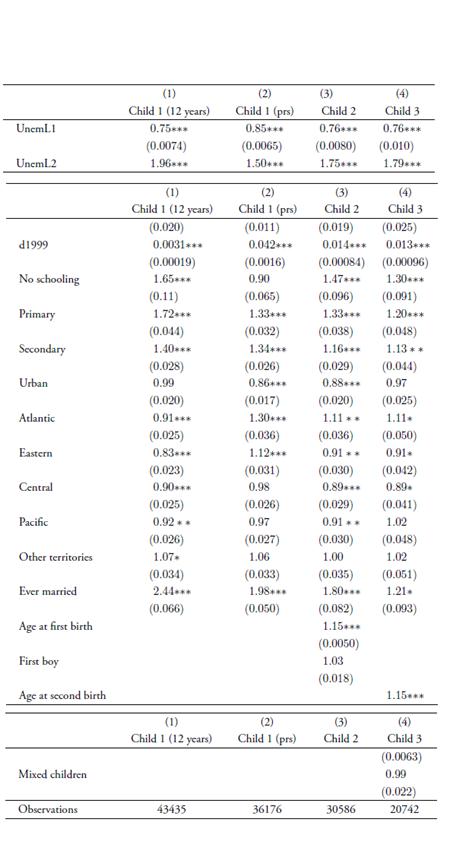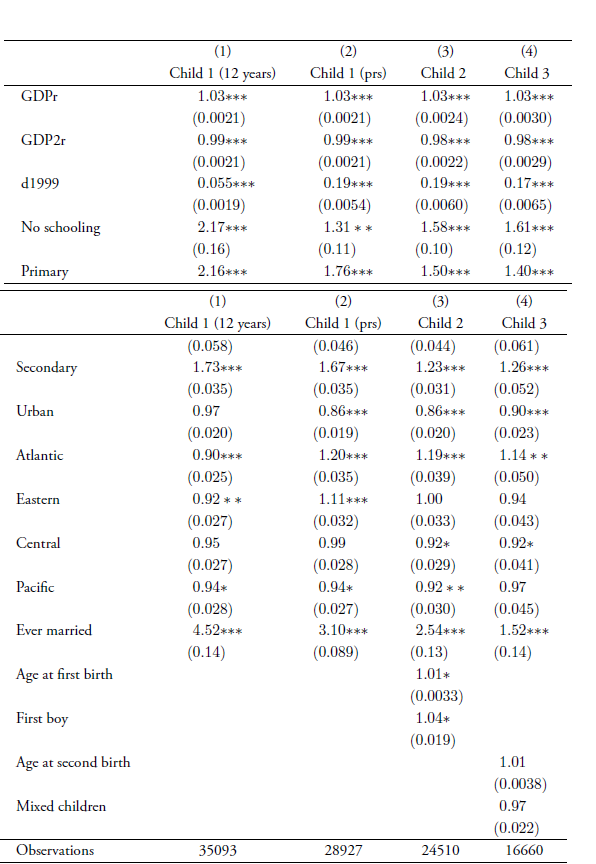Economic conditions and birth spacing in Colombia: a semi-parametric approach
DOI:
https://doi.org/10.17533/udea.le.n87a04Keywords:
survival analysis, Cox proportional hazards model, birth spacing, fertility decisions, ColombiaAbstract
This document aims to provide evidence on the association between economic conditions and household fertility decisions related to birth spacing by using a Cox proportional hazards model. The contribution of the paper is twofold: first, it adds to the scarce existing literature on this topic for Latin America by offering evidence for Colombia; second, local heterogeneity in economic performance is considered by using regional economic growth as a shock potentially modifying household decisions. We find that better economic performance is associated with reductions in birth spacing. Thus, it seems that demand for children might be procyclical, an income effect predominating; however, when good conditions persist, demand for children decreases, suggesting the dominance of a substitution effect. An alternative interpretation is simply that economic growth increases the probability of having children, automatically reducing the risk after the boom.
Downloads
References
Adsera, Alicia & Menéndez, Alicia (2011). “Fertility changes in Latin America in the context of economic and political uncertainty”, Population Studies, Vol. 65, No. 1, pp. 37-57.
Angrist, Joshua & Evans, William (1998). “Children and Their Parents’ Labor Supply: Evidence from Exogenous Variations in Family Size”, American Economic Review, Vol. 88, No. 3, pp. 450-477.
Becker, Gary (1960). “An economic analysis of fertility”. In: Demographic and economic change in developed countries (pp. 209-240). Cambridge, USA: National Bureau of Economic Research.
Becker, Gary & Lewis, H. Gregg (1973). “On the interaction between the quantity and quality of children”, Journal of Political Economy, Vol. 81, No. 2, pp. S279-S288.
Billingsley, Sunnee (2011). “Economic crisis and recovery: Changes in second birth rates within occupational classes and educational groups”, Demographic Research, Vol. 24, pp. 375-406.
Boongarts, John (1978). “A framework for analyzing the proximate determinants of fertility”, Population and Development Review, Vol. 4, No. 1, pp. 105-132.
Butz, William & Ward, Michael (1979). “The emergence of countercyclical U.S. fertility”, American Economic Review, Vol. 69, No. 3, pp. 318-328.
Cleves, Mario; Gould, William & Gutiérrez, Roberto (2004). An Introduction to Survival Analysis Using Stata. Texas: Stata Press.
Conde, Luis; Rueda, Álvaro; Gracia, Beatriz; Hormaza, Ángela & Agudelo, Juan Carlos (2003). “Edad sexual en escolares de Cali, Colombia”, Colombia Médica, Vol. 34, No. 2, pp. 69-76.
Davis, Kingsley & Blake, Judith (1956). “Social structure and fertility: An analytic framework”, Economic Development and Cultural Change, Vol. 4, No. 3, pp. 211-235.
Easterlin, Richard (1975). “An Economic Framework for Fertility Analysis”, Studies in Family Planning, Vol. 6, No. 3, pp. 54-63.
Gutiérrez-Domènech, Maria (2008). “The impact of the labour market on the timing of marriage and births in Spain”, Journal of Population Economics, Vol. 21, No. 1, pp. 83-110.
Karatepe, Zakir Selim (2009). Effects of economic crisis on marital fertility in Turkey. Master’s thesis, Department of Economic History, Lund University, Sweden.
Kertzer, David; White, Michael; Bernardi, Laura & Gabrielli, Giuseppe (2009). “Italy’s path to very low fertility: the adequacy of economic and second demographic transition theories”, European Journal of Population, Vol. 25, No. 1, pp. 89-115.
Kirk, Dudley (1960). “The influence of business cycles on marriage and birth rates”. In: Demographic and economic change in developed countries (pp. 241-260). Cambridge, USA: National Bureau of Economic Research.
Mckenzie, David (2003). “How do Households Cope with Aggregate Shocks? Evidence from the Mexican Peso Crisis”, World Development, Vol. 31, No. 7, pp. 1179-1199.
Macunovich, Diane J. (1995). “The Butz-Ward fertility model in the light of more recent data”, Journal of Human Resources, Vol. 30, No. 2, pp. 229-255.
Macunovich, Diane J. (1996). “Relative income and price of time: exploring their effects on U.S. fertility and female labor participation”, Population and Development Review, Vol. 22 (Supplement: Fertility in the United States: New Patterns, New Theories), pp. 223-257.
Meron, Monique & Widmer, Isabelle (2002). “Unemployment leads women to postpone the birth of their first child”, Population, Vol. 57, No. 2, pp. 301-330.
Mocan, Naci H. (1990). “Business cycles and fertility dynamics in the United States”, Journal of Population Economics, Vol. 3, No. 2, pp. 125-146.
Newman, John L. & McCulloch, Charles E. (1984). “A hazard rate approach to the timing of births”, Econometrica, Vol. 52, No. 4, pp. 939-961.
Özcan, Berkay; Mayer, Karl Ulrich & Luedicke, Joer (2010). “The impact of unemployment on the transition to parenthood”, Demographic Research, Vol. 23, pp. 807-846. .
Retherford, Robert; Ogawa, Naohiro; Matsukura, Rikiya & Eini-Zinab, Hassam (2010). “Multivariate analysis of parity progression-based measures of the total fertility rate and its components”, Demography, Vol. 47, No. 1, pp. 97-124.
Sobotka, Tomas; Skirbekk, Vegard & Philipov, Dimiter (2011). “Economic recession and fertility in the developed world”, Population and Development Review, Vol. 37, No. 2, pp. 267-306.
Testa, Maria Rita & Basten, Stuart (2012). “Have Lifetime Fertility Intentions Declined During the Great Recession?”, Working Papers, No. 9/2012. Vienna Institute of Demography WP, Austria.
Wang, Ping; Yip, Chong & Scotese, Carol (1994). “Fertility choice and economic growth: theory and evidence”, Review of Economics and Statistics, Vol. 76, No. 2, pp. 255-266.
Published
How to Cite
Issue
Section
License
Copyright (c) 2017 Blanca Cecilia Zuluaga Díaz, Luis Fernando Gamboa Niño, Luis Eduardo Jaramillo Flechas

This work is licensed under a Creative Commons Attribution-NonCommercial-ShareAlike 4.0 International License.
This page, by Universidad de Antioquia, is licensed under a Creative Commons Attribution License.
Authors who publish with this journal agree to retain copyright and grant the journal right of first publication, with the article licensed under a Creative Commons Attribution-NonCommercial-ShareAlike License allowing others to share it as long as they acknowledge its authorship and original publication in this journal.
Authors can enter into separate, additional contractual arrangements for the non-exclusive distribution of the journal's published version of the work (e.g., post it to an institutional repository or publish it in a book), provided that these arrangements be not for profit and the journal be acknowledged as the original source of publication.
Authors are permitted and encouraged to post their papers online (e.g., in institutional repositories or on their websites), as it can lead to valuable exchanges as well as greater citation of the published work.


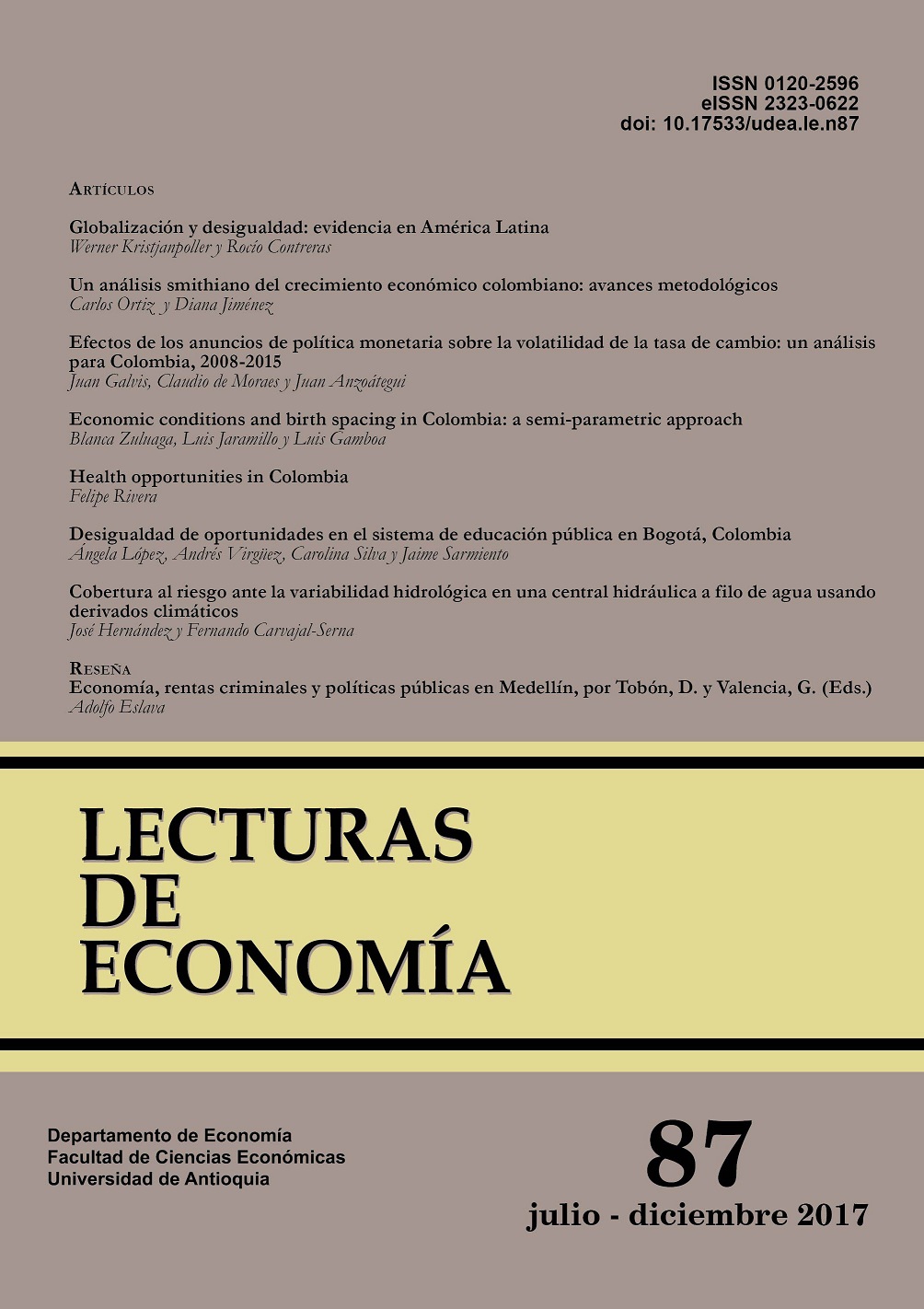




 as
as  (
( (
( child does not occur, the time period is set between the date of birth of the
nth-1
child and the date of the survey, unless the woman had a sterilization procedure; in this case, T is the date of the sterilization.
child does not occur, the time period is set between the date of birth of the
nth-1
child and the date of the survey, unless the woman had a sterilization procedure; in this case, T is the date of the sterilization.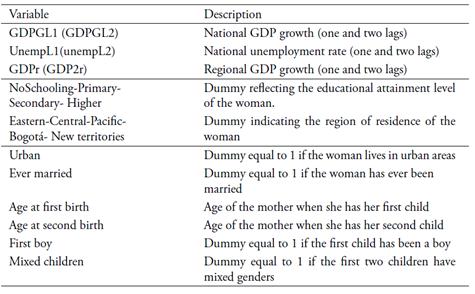
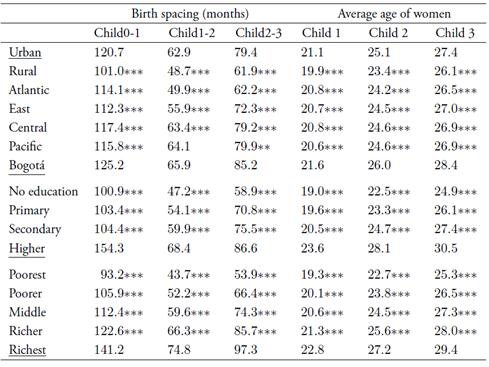
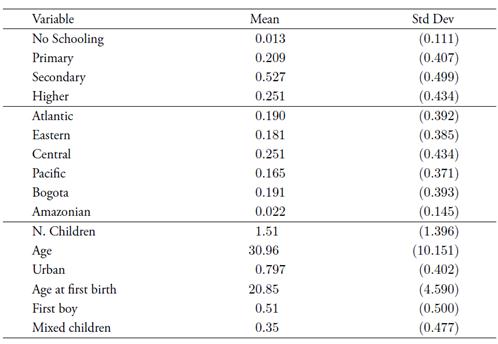

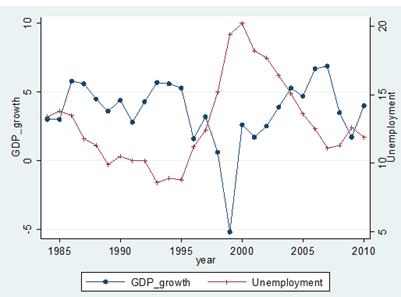

 as explained before. The third column refers to the birth spacing between the first and the second child, and the fourth column presents spacing between the second and the third child.
as explained before. The third column refers to the birth spacing between the first and the second child, and the fourth column presents spacing between the second and the third child.
